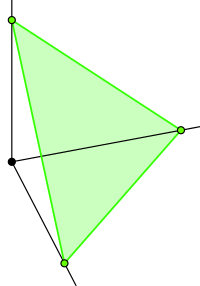Sample uniformly at random from an n-dimensional unit simplex
Sampling uniformly at random from an n-dimensional unit simplex is the fancy way to say that you want n random numbers such that
- they are all non-negative,
- they sum to one, and
- every possible vector of n non-negative numbers that sum to one are equally likely.
In the n=2 case you want to sample uniformly from the segment of the line x+y=1 (ie, y=1-x) that is in the positive quadrant. In the n=3 case you're sampling from the triangle-shaped part of the plane x+y+z=1 that is in the positive octant of R3:

(Image from http://en.wikipedia.org/wiki/Simplex.)
Note that picking n uniform random numbers and then normalizing them so they sum to one does not work. You end up with a bias towards less extreme numbers.
Similarly, picking n-1 uniform random numbers and then taking the nth to be one minus the sum of them also introduces bias.
Wikipedia gives two algorithms to do this correctly: http://en.wikipedia.org/wiki/Simplex#Random_sampling (Though the second one currently claims to only be correct in practice, not in theory. I'm hoping to clean that up or clarify it when I understand this better. I initially stuck in a "WARNING: such-and-such paper claims the following is wrong" on that Wikipedia page and someone else turned it into the "works only in practice" caveat.)
Finally, the question: What do you consider the best implementation of simplex sampling in Mathematica (preferably with empirical confirmation that it's correct)?
Related questions
This code can work:
samples[n_] := Differences[Join[{0}, Sort[RandomReal[Range[0, 1], n - 1]], {1}]]
Basically you just choose n - 1 places on the interval [0,1] to split it up then take the size of each of the pieces using Differences.
A quick run of Timing on this shows that it's a little faster than Janus's first answer.
- Distinguish between two maximum values in a column with Power Query
- Power Query Conditional JOIN - JOIN with WHERE clause
- Calculate combinations for a range of text values in excel
- How to update a column's values in Power BI M Language
- What's the difference between DAX and Power Query (or M)?
- Sorting issue when consolidating monthly data into a year to date file. Using query, sorting by day, time, and letter
- Power Query `List.Generate` runs too slow
- Custom Colum based on specific dates in powerquery
- How do I properly use table.group in a PowerQuery query to dynamically summarize different rows and columns?
- Excel Power Query syntax issue transform multiple columns of records
- How to capitalize only first letter of a sentence
- Power Query Import For Power BI with group by on SelectRows
- Get data from config table cell when loading data source with power query
- Translate Excel Formula into Power Query
- Counting matching pairs of letters in lists of bigrams in Power Query M
- Bigrams of a string in Power Query M
- Power Query code to refer to another query (and how buffering works)
- M code for the equivalent of of Left (string, len(string)-11)
- How to add a missing column to the Transform Sample File
- How to add or insert ' (single quotes) for every string in a list in which strings are separated by commas in Power Query
- Power BI M code Split column from Lowercase to Uppercase won't include diacritics (accents)
- M Code(Power Query) to Remove Empty columns that runs fast
- How to find the value with date closest to another date
- Error when build AOSP 14 - internal error: undefined variable CTS_TEST_SUITES_DEFAULT
- Call a table using a dynamic identifier
- Problem getting the value from a cell using M in excel
- How to rename columns based on the data within them in Power Query M?
- Power Query return a field name based on parameter
- Power Query: after combining 2 tables got something strange
- Token Literal Expected Error in Power Query M Code using try and List.MatchesAny